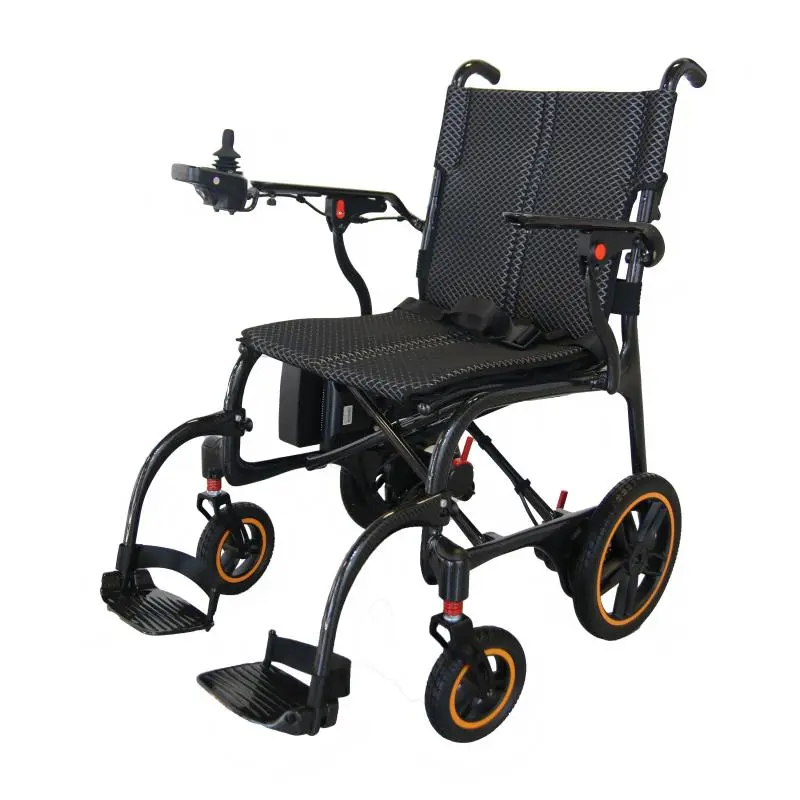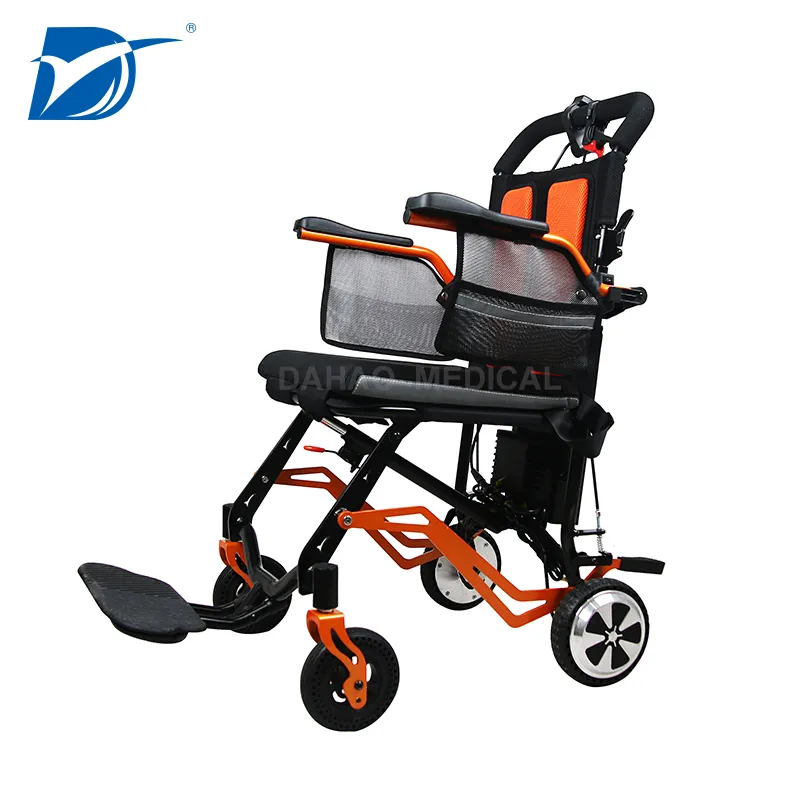With an aging population, rising rehabilitation needs, and technological advancements, electric wheelchairs have moved from hospital-only equipment into homes and urban public spaces. However, there's more than just one type of electric wheelchair. A commonly used market classification framework categorizes these products into three types: portable electric wheelchairs, standard electric wheelchairs, and heavy-duty electric wheelchairs.
These three types differ significantly in design purpose, overall weight, load capacity, battery life, and applicable scenarios. Failure to accurately match consumer and institutional needs can lead to wasted budgets and compromised safety and quality of life.
This article systematically addresses the question, "What are the three types of electric wheelchairs?" by focusing on definitions, structural differences, clinical and lifestyle compatibility, regulatory standards, market trends, and key purchase and maintenance considerations, offering practical purchasing and usage recommendations.

What are the three types of electric wheelchairs?
Generally, in the industry and retail market, there are three basic types of electric wheelchairs:
• Portable power chairs (travel/portable power chairs): These emphasize lightweight, detachable/foldable design for easy transportation, transportation, and travel. They are suitable for users with limited mobility who frequently travel.
• Standard power wheelchairs: Suitable for both indoor and outdoor use, they offer comprehensive functionality and can be configured with a variety of seating adjustments and electrical accessories, making them suitable for a wide range of applications.
• Heavy-duty (bariatric) power wheelchairs: Designed for heavier users or those requiring greater off-road performance and durability, they typically feature higher load capacities, sturdier chassis, and more powerful power.
(The above three categories are a general and practical market categorization; different manufacturers may further subdivide these categories, for example, by drive wheel location, categorizing them into front-wheel, mid-wheel, and rear-wheel drive, or by seat positioning, into "complex rehabilitation technology (CRT)" and "conventional power chairs.")

Portable, standard, and heavy-duty: What are the differences between the three types of power wheelchairs?
1. Portable power wheelchairs – prioritize "lightness" and "travel convenience"
Portable power wheelchairs are primarily designed for frequent travelers, travelers, and families who frequently use their vehicles. Their design goal is to lower the barrier to full vehicle transportability, allowing one person to disassemble or fold the wheelchair and stow it in a car trunk, train luggage compartment, or onboard (subject to airline battery requirements).
Typical Features:
• The overall weight is significantly lower than conventional electric wheelchairs (lightweight models can weigh as little as 10 to over 30 kilograms, depending on whether a battery is included and how it is integrated).
• The frame is often constructed of lightweight alloy or carbon fiber components, and the structure is foldable or disassembled; the power system and battery are often detachable for portability.
• The range, load-bearing capacity, and off-road performance are generally inferior to similarly priced standard wheelchairs, but they perform well in flat urban environments and for short trips.
• Advantages/Disadvantages at a Glance: The advantages of portable electric wheelchairs are portability and ease of travel; disadvantages include limited load-bearing capacity, stability, suspension, and off-road capabilities.
2. Standard Electric Wheelchairs – A "Jack of All Trades" for Multiple Scenarios
Standard electric wheelchairs are the most common type, intended for users who need daily transportation at home, in the community, and for small outdoor activities. Hospitals, rehabilitation centers, and nursing homes also widely use standard models as standard equipment.
Typical Features:
• Stable body, with a wide range of seat and posture support options (including seat cushions, side supports, and seat tilt and lift).
• Above-average range and speed, with tire and suspension designs that balance indoor maneuverability and outdoor comfort.
• Available with a variety of drive options (front-wheel drive, mid-wheel drive, and rear-wheel drive), and support for a comprehensive range of control interfaces (joystick, hand controls, head controls, foot controls, etc.).
• Advantages/Disadvantages at a Glance: Standard electric wheelchairs offer wide adaptability and balance comfort and maneuverability. Disadvantages include being heavier than portable models and less convenient to assemble and disassemble.
3. Heavy-Duty Electric Wheelchairs – Focusing on Load-Bearing Capacity and Durability (Bariatric / Heavy-Duty)
Heavy-duty electric wheelchairs are designed for individuals with larger weights (bariatric), those who need to carry rehabilitation equipment (such as lift seats and rehabilitation braces), or those who navigate complex outdoor terrain. These models are preferred in nursing homes, long-term care centers, and specialized disability rehabilitation settings.
Typical Features:
• High-strength chassis, larger wheel diameter, and more powerful power unit; load capacity typically ranges from 200–450 kg (depending on the model).
• Often comes with stronger suspension and damping, larger battery capacity, and optional lift/power positioning.
• Typically more expensive and heavier than standard models in the same class, but offers longer life and greater reliability.

Portable, Standard, and Heavy-Duty Electric Wheelchairs: How Should I Choose?
To help you quickly understand the differences, here's a comparison based on five dimensions: portability, load capacity, battery life/battery, off-road capability, and price:
• Portability: Portable Electric Wheelchair >> Standard Electric Wheelchair > Heavy-Duty Electric Wheelchair.
• Load Capacity: Heavy-Duty Electric Wheelchair >> Standard Electric Wheelchair > Portable Electric Wheelchair.
• Battery Life/Battery Capacity: Heavy-Duty and Standard models typically offer larger batteries and longer battery life; portable models trade off weight for shorter battery life.
• Off-road/Gradeability: Heavy-duty electric wheelchairs are best (powerful motor, high torque at low speeds); standard models are second; portable models are primarily for smooth surfaces.
• Price Range (roughly): Portable models range from entry-level to mid-range; standard models range from mid-range to high-end; heavy-duty models are generally high-end and have a high degree of price flexibility (the more features and the higher the load capacity, the higher the price).
When choosing a wheelchair, prioritize the "use scenario." For example, frequent travelers who need to carry their wheelchair on airplanes or in cars should consider portable electric wheelchairs. Those who require daily multi-surface use and prioritize comfort and accessories should choose standard electric wheelchairs. Those who are overweight or need to carry special equipment should prioritize heavy-duty electric wheelchairs and verify their load capacity and mandatory test certificates.
Electric Wheelchairs: Why Should You Care About ISO/National Standards and Electromagnetic Compatibility?
Electric wheelchairs are classified as medical devices/assistive devices and have strict standards for structural safety, electrical safety, EMC (electromagnetic compatibility), durability, and impact testing. Internationally, the ISO 7176 series serves as the core standard, covering energy consumption testing, brake effectiveness, impact, gradeability, and electrical compatibility testing. China has also adopted and published supporting standards in these areas. When purchasing a wheelchair, be sure to check whether the manufacturer lists an ISO 7176 or equivalent national standard inspection report.
The importance of standardization lies in the fact that a wheelchair that fails basic fatigue, impact, and electrical testing may pose real-world hazards (such as chassis fatigue, motor overload, brake failure, or battery short circuit). For heavy electric wheelchairs, chassis fatigue resistance and weld quality are particularly important for safe use.
Important Note on Batteries and Travel (Airlines/Long-Distance)
The battery type (lead-acid, AGM, sealed lead-acid, lithium-ion) used in electric wheelchairs directly affects range, weight, and air transportability.
Airlines and civil aviation regulators have strict restrictions on lithium batteries. For example, the US FAA/IATA has clear regulations on watt-hour (Wh) limits and carriage requirements for lithium-ion batteries. There are upper limits on the battery capacity that can be carried on board, and in some cases, prior declaration and airline approval are required.
Users planning to travel with a power wheelchair should consult with the airline in advance and prepare the necessary documentation to confirm whether the battery is removable, whether it can be carried as carry-on baggage, and whether special packaging is required.
Practical Tip: Although portable power wheelchairs are easy to disassemble and assemble, if the battery contains a large-capacity lithium battery (approaching or exceeding aviation restrictions), it is important to confirm with the airline and follow the relevant procedures before boarding. Some airlines have additional restrictions on devices with non-removable batteries.
Suitability of Three Types of Power Wheelchairs for Medical/Nursing Use
1. Portable power wheelchairs are suitable for patients in the early stages of recovery who need short trips, family members who need to load the vehicle, or those seeking increased independence when traveling. However, they are not suitable for those who are permanently recumbent, severely disabled, or require complex positioning support.
2. Standard electric wheelchairs are a common foundation for rehabilitation facilities. They can be fitted with a variety of cushions, side supports, and respiratory/nutrition support braces, offering a wide range of adaptability.
3. Heavy-duty electric wheelchairs are commonly used by patients who are overweight, require a seat lift or hoist, or require high off-road capability and durability. Rehabilitation physicians/occupational therapists assess the user and consider skin pressure risk, transfer ability, sciatica support, and body size to determine the appropriate model and seat configuration.
In healthcare facilities, selecting an electric wheelchair often requires a multidisciplinary assessment (including rehabilitation physicians, therapists, nursing, and engineering departments), along with testing for cushion pressure distribution, transport compatibility, and emergency evacuation plans.

What are the three types of electric wheelchairs?
Returning to the news headline, "What are the three types of electric wheelchairs?", the answer is: portable electric wheelchairs, standard electric wheelchairs, and heavy-duty electric wheelchairs. Each of the three categories presents trade-offs in terms of lightweight, fit, load-bearing capacity, and battery life. Consumers, rehabilitation institutions, and purchasers should make decisions based on a comprehensive process of "usage scenario - human body assessment - safety standards - after-sales guarantee," rather than making impulse purchases based solely on appearance or price.
Can Dayang Medical customize products for buyers?
Yes, customization is one of our core strengths. As a professional China manufacturer, Dayang Medical provides OEM and ODM services for international buyers who require customized medical devices. From electric wheelchair designs to hospital beds and walking aids, we can adapt to different branding requirements and functional needs. Our factory offers wholesale supply, competitive prices, and flexible purchasing solutions. Buyers can request customized products with logos, packaging, or special features at affordable prices.










